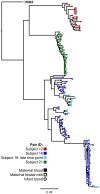4E10-resistant HIV-1 isolated from four subjects with rare membrane-proximal external region polymorphisms
- PMID: 20352106
- PMCID: PMC2843716
- DOI: 10.1371/journal.pone.0009786
4E10-resistant HIV-1 isolated from four subjects with rare membrane-proximal external region polymorphisms
Abstract
Human antibody 4E10 targets the highly conserved membrane-proximal external region (MPER) of the HIV-1 transmembrane glycoprotein, gp41, and has extraordinarily broad neutralizing activity. It is considered by many to be a prototype for vaccine development. In this study, we describe four subjects infected with viruses carrying rare MPER polymorphisms associated with resistance to 4E10 neutralization. In one case resistant virus carrying a W680G substitution was transmitted from mother to infant. We used site-directed mutagenesis to demonstrate that the W680G substitution is necessary for conferring the 4E10-resistant phenotype, but that it is not sufficient to transfer the phenotype to a 4E10-sensitive Env. Our third subject carried Envs with a W680R substitution causing variable resistance to 4E10, indicating that residues outside the MPER are required to confer the phenotype. A fourth subject possessed a F673L substitution previously associated with 4E10 resistance. For all three subjects with W680 polymorphisms, we observed additional residues in the MPER that co-varied with position 680 and preserved charged distributions across this region. Our data provide important caveats for vaccine development targeting the MPER. Naturally occurring Env variants described in our study also represent unique tools for probing the structure-function of HIV-1 envelope.
Conflict of interest statement
Figures




Similar articles
-
Analysis of the human immunodeficiency virus type 1 gp41 membrane proximal external region arrayed on hepatitis B surface antigen particles.Virology. 2008 Mar 30;373(1):72-84. doi: 10.1016/j.virol.2007.11.005. Epub 2007 Dec 26. Virology. 2008. PMID: 18155743 Free PMC article.
-
Anti-human immunodeficiency virus type 1 (HIV-1) antibodies 2F5 and 4E10 require surprisingly few crucial residues in the membrane-proximal external region of glycoprotein gp41 to neutralize HIV-1.J Virol. 2005 Jan;79(2):1252-61. doi: 10.1128/JVI.79.2.1252-1261.2005. J Virol. 2005. PMID: 15613352 Free PMC article.
-
4E10-resistant variants in a human immunodeficiency virus type 1 subtype C-infected individual with an anti-membrane-proximal external region-neutralizing antibody response.J Virol. 2008 Mar;82(5):2367-75. doi: 10.1128/JVI.02161-07. Epub 2007 Dec 19. J Virol. 2008. PMID: 18094155 Free PMC article.
-
Neutralizing Antibodies Targeting HIV-1 gp41.Viruses. 2020 Oct 23;12(11):1210. doi: 10.3390/v12111210. Viruses. 2020. PMID: 33114242 Free PMC article. Review.
-
Antigp41 membrane proximal external region antibodies and the art of using the membrane for neutralization.Curr Opin HIV AIDS. 2017 May;12(3):250-256. doi: 10.1097/COH.0000000000000364. Curr Opin HIV AIDS. 2017. PMID: 28422789 Review.
Cited by
-
Neutralizing epitopes in the membrane-proximal external region of HIV-1 gp41 are influenced by the transmembrane domain and the plasma membrane.J Virol. 2012 Mar;86(6):2930-41. doi: 10.1128/JVI.06349-11. Epub 2012 Jan 11. J Virol. 2012. PMID: 22238313 Free PMC article.
-
Breast milk and in utero transmission of HIV-1 select for envelope variants with unique molecular signatures.Retrovirology. 2017 Jan 26;14(1):6. doi: 10.1186/s12977-017-0331-z. Retrovirology. 2017. PMID: 28122636 Free PMC article.
-
A Conserved Glycan in the C2 Domain of HIV-1 Envelope Acts as a Molecular Switch to Control X4 Utilization by Clonal Variants with Identical V3 Loops.PLoS One. 2015 Jun 17;10(6):e0128116. doi: 10.1371/journal.pone.0128116. eCollection 2015. PLoS One. 2015. PMID: 26083631 Free PMC article.
-
Closing the door to human immunodeficiency virus.Protein Cell. 2013 Feb;4(2):86-102. doi: 10.1007/s13238-012-2111-9. Epub 2013 Mar 12. Protein Cell. 2013. PMID: 23479426 Free PMC article. Review.
-
HIV-1 specific antibody titers and neutralization among chronically infected patients on long-term suppressive antiretroviral therapy (ART): a cross-sectional study.PLoS One. 2014 Jan 15;9(1):e85371. doi: 10.1371/journal.pone.0085371. eCollection 2014. PLoS One. 2014. PMID: 24454852 Free PMC article.
References
-
- Douek DC, Kwong PD, Nabel GJ. The rational design of an AIDS vaccine. Cell. 2006;124:677–681. - PubMed
-
- Montefiori DC. Neutralizing antibodies take a swipe at HIV in vivo. Nat Med. 2005;11:593–594. - PubMed
-
- Zwick MB. The membrane-proximal external region of HIV-1 gp41: a vaccine target worth exploring. AIDS. 2005;19:1725–1737. - PubMed
Publication types
MeSH terms
Substances
Grants and funding
LinkOut - more resources
Full Text Sources
Molecular Biology Databases

